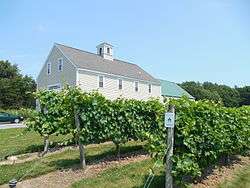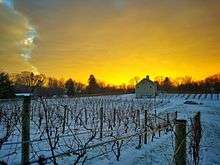Jewell Towne Vineyards

Jewell Towne Vineyards is a winery in the state of New Hampshire. The property is located on the hills overlooking the Powwow River a few miles from the Atlantic Ocean. The property is the oldest currently producing winery in New Hampshire,[1][2][3][4] and is seen as a leader in establishing northern New England cold hardy cultivars.[5]

History
In 1982 Peter Oldak of South Hampton, New Hampshire, a former emergency room physician, planted six grapevines[1][6] in his backyard to complement his small garden and orchard.[7] With time he concluded the microclimate of his 13 acres (5.3 ha) property was very similar to that of the Finger Lakes region of New York and was well suited to growing grapes, despite common misconceptions.[2][7]
In 1994 Jewell Towne Vineyards became a licensed commercial enterprise,[2][8] and the first 40 cases were released.[2] Having made the wine in the Oldak home basement until 1996,[6] the construction of a winery was completed in 1999, containing a wine cellar, bottling room, a large tasting room and a balcony used as an art gallery to exhibit work from local artists.[2]
Since 1994 Jewell Towne Vineyards wines have won an array of awards from national competitions and state fairs.[2][7][9][10][11]
Oldak has also formed the New Hampshire Winery Association, aiming to support local vintners,[12] and works with the University of New Hampshire teaching viticulture and winemaking.[1][2]
Production
Initially experimenting with more than sixty grape varieties,[1] the number was eventually reduced to approximately twenty of the most varieties deemed most promising by 1990.[6] While a varied selection of grape varieties, there is an emphasis on cold hardy varieties,[5] but also Vitis vinifera varieties, such as Chardonnay, Gewürztraminer and Riesling.[7] Among the cultivated hybrids are Aurore, Seyval, Vidal blanc, Vignoles and Marechal Foch.[1] Oldak has declared a mission to bring Landot noir back to respectability.[13] In addition to red and white varietal wines, the winery produces blush and ice wines,[1][8] and a "port" that is made from the Chancellor grape.
Jewell Towne produces 35,000 bottles a year,[2] requiring more fruit than can possibly be cultivated on the 5-acre (2.0 ha) vineyard, and therefore imports roughly 70% of the grapes from New York and California.[12] As the state line dividing New Hampshire and Massachusetts runs through the property, some of the wines bear "New Hampshire 50% & Massachusetts 50%" on the label.[1]
References
- 1 2 3 4 5 6 7 Cattell, Hudson. Wine East. appellationamerica.com ( Jan-Feb 2004 ). The Wineries of New Hampshire
- 1 2 3 4 5 6 7 8 Bisceglia, Mike, Jr.Seacoastonline.com (July 17, 2007). Recapturing area's wine-making past
- ↑ Cattell, Hudson, Wines & Vines (December 8, 2008). "New Hampshire Producers Stand Together".
- ↑ Zraly, Kevin (2006). Kevin Zraly's American Wine Guide. New York: Sterling. p. 116. ISBN 1-4027-2585-X.
- 1 2 Seacoastonline.com (February 26, 2008). Jewell Towne Vineyards produces new wine
- 1 2 3 DeVito, Carlo (2004). East Coast Wineries: A Complete Guide from Maine to Virginia. Rutgers University Press. pp. 46–47. ISBN 978-0-8135-3312-4.
- 1 2 3 4 Dial, Adam, appellationamerica.com (March 11, 2004). Dr. Peter Oldak – Laying a Solid Foundation for New Hampshire Viticulture
- 1 2 "The time is ripe." New Hampshire Union Leader (Manchester, NH) September 27, 2004, State, Business: C1.
- ↑ Forrest, harriet, The Hampton Union (April 20, 2004). Sip & Sample
- ↑ Craig, Steve, The Hampton Union (September 30, 2003). Wine-making hobby harvests delicious rewards
- ↑ "South Hampton vintner wins 7 medals." New Hampshire Union Leader (Manchester, NH) August 30, 2004, State, Business: C2.
- 1 2 Wacker, Tim, Boston Globe (November 5, 2006). Splendor in a glass: The romance of wine-making appeals to growing crop of N.E. vintners
- ↑ Chien, Mark, jancisrobinson.com (November 17, 2006). In praise of grape varietal diversity
External links
Coordinates: 42°52′17.5″N 70°57′34.6″W / 42.871528°N 70.959611°W